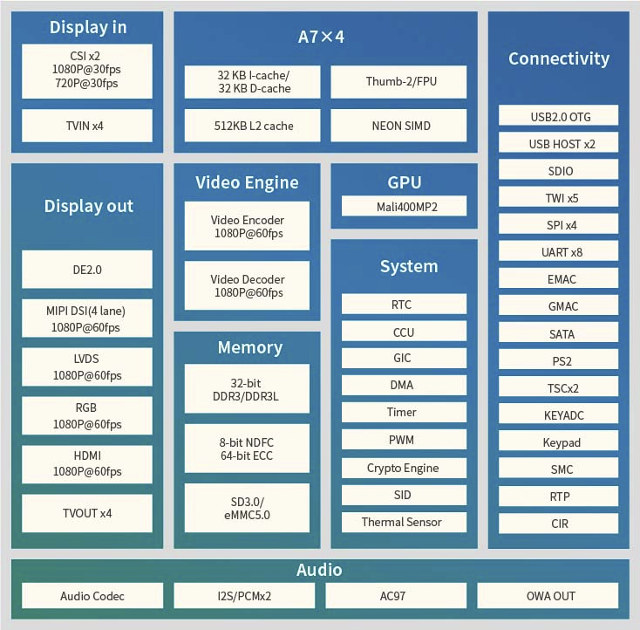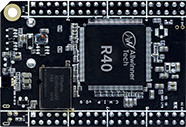One of the most common complaints I get from readers when I publish news about new ARM processor is “Why didn’t they include SATA?”. So far Allwinner A20 is the only really low cost ARM processor that includes a SATA port, but it’s been released a few years, and its dual core Cortex A7 processor is getting old. We’ve been hearing rumors about an upgraded version for one or two years with Allwinner A40 or more recently Allwinner A20E, and finally the company has now published details about Allwinner R40 processor on their revamped website, which they claim to be the successor of Allwinner A20.

Allwinner R40 key specifications:
- CPU – Quad-core ARM Cortex-A7 Processor
- GPU – Mali-400 MP2 GPU
- Memory I/F – 32-bit DDR3/DDR3L/LPDDR2/LPDDR3
- Storage I/F – 8-bit NAND flash, SD3.0, eMMC 5.0, and 1x SATA
- Networking – 2x MAC: 1x EMAC (10/100M Ethernet), 1x GMAC (Gigabit Ethernet)
- Display – RGB/LVDS/HDMI/MIPI DSI/TV Out
- Video – 1080p@60fps decoding and H.264 HP 1080p@60fps encoding
- Audio – Up to 2x I2S/PCM interfaces, eight channels of Time Division Multiplexing(TDM) with sampling precision up to 32bit/192KHz
- Camera- 2x Parallel MIPI CSI interfaces
- USB – 3x USB 2.0 host
- I/Os – 8x UART, 4x SPI, 5x TWI/I2C
- STB interfaces – 1x smart card, 2x TS
- Misc – 2x PS2 1x 8×8 keypad, 2x IR receiver, 2x KEYADC, RTP
- Package – 16×16 mm FBGA468
Compared to Allwinner A20, the company explains that R40 is an “Allwinner A20 upgrade edition” with four cores instead of two, 40nm process instead of 55nm, lower power consumption, and a smaller package. They also mention the processor will be supported by their lightweight open source Tina operating system based on Linux.
One of the first devices to use the new processor, beside the unnamed CPU module shown above (Update: that’s a photoshopped C.H.I.P board), will be Banana Pi M2 Ultra development board, which will come with 2GB RAM, 8GB flash, and expose the SATA interface.

Jean-Luc started CNX Software in 2010 as a part-time endeavor, before quitting his job as a software engineering manager, and starting to write daily news, and reviews full time later in 2011.
Support CNX Software! Donate via cryptocurrencies, become a Patron on Patreon, or purchase goods on Amazon or Aliexpress





